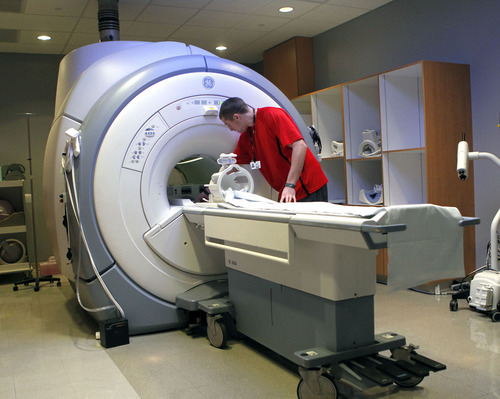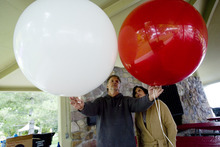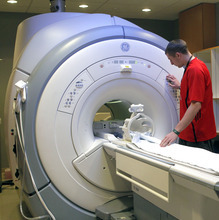This is an archived article that was published on sltrib.com in 2012, and information in the article may be outdated. It is provided only for personal research purposes and may not be reprinted.
The helium used in today's party balloons first caught the attention of the U.S. Army during World War I when the lighter-than-air gas was seen as the safest way to keep giant airships afloat.
Since the days of military dirigibles, the federal government has controlled the U.S. helium market. But now private demand is outstripping federal needs, causing an artificial spike in prices and a shortage that is having an impact on everything from birthday gatherings to the most sophisticated machinery in Utah and beyond.
Neither issue can be corrected until new plants come online or until Congress acts on a stalled bill that addresses helium supplies controlled by the federal government. With the political gridlock in Washington, action soon seems unlikely.
Helium for party balloons, perhaps the use of the gas consumers notice most, actually accounts for only a small percentage of demands. It also is used as a supercoolant in nuclear reactors and in aerospace arc welding and computer chip manufacturing.
Other applications cover a range of devices, from cooling lasers and MRI machines to being included in backpack systems used to detect dirty bombs. It also is vital for heart catheterization methods. At this point, supplies of helium appear adequate to meet medical needs but MRI manufacturers are worried that continued tight supplies could affect patient care by disrupting scanner service.
—
Limited supply • Other impacts have been more immediate.
Distributor Nikki Russell, owner of Arc Helium Supply in Salt Lake City, said he sometimes receives as little as 60 percent of the helium supplies he needs. And as a result, Russell said, ``we're supplying only customers who have been with us for quite some time, not someone who calls us for balloons for an event or a wedding."
Customers big and small also are paying more. The crude helium price set by the federal government per thousand cubic feet was $64.75 two years ago. Today it's posted at $84.
Perhaps the most visible consequence of the shortage is the one that hits at home. Although parents and others who want helium-filled balloons for parties generally can still get them, for a time recently there were limits on the number of balloons, and some stores simply ran out of helium.
That seems to have passed, for the most part, but the scarceness gave rise to cheaper alternatives.
Steve Nielsen, owner of Balloon Bonanza in Sandy, uses air to fill balloons, which are then tied to frames, columns or other types of supports to secure his decorative creations and to achieve ornamental heights.
"Not everything we do is with helium, it's about half of what we used to do," he said. "Helium is not only in short supply, but prices have gone up 25 percent in the past three months alone."
—
Medical care concerns • More pressing is a possible shortage as it relates to MRI machines. Magnetic resonance imaging scanners use powerful magnets to generate a magnetic field, which is used to peer inside the human body. But to generate that field, the scanners rely on liquid helium's extreme cold, about minus 452 degrees Fahrenheit, to transform the magnets into superconductors, allowing for greater detail in body scans. Liquid helium is the coldest liquid, with a freezing point of minus 459.7 Fahrenheit. There is no known substitute.
Although the scarcity of helium has not had a direct impact on patient care at medical facilities in the Salt Lake Valley, there are worries that it could.
"Our MRIs are very efficient in using the helium, we only have to refill the machines once a year," said Edwin "Steve" Stevens, chairman of the University of Utah's Department of Radiology. "We also have a contract for service maintenance, which has two years left on the contract. But if we don't find a replacement source, the shortage could affect us later."
At Intermountain Healthcare, spokesman Jess Gomez said GE Healthcare, which provides MRI systems to Intermountain and services the machines, has given assurances there will be adequate supplies of helium for now.
But GE Healthcare has concerns.
Helium is absolutely essential to MRI production, Tom Rauch global sourcing manager for GE Healthcare, told a Senate committee in May. Although GE is trying to conserve helium during the manufacturing process, MRI machines still need a lot of the gas. Depending on the type of scanner being produced, a machine needs from 4,000 liters to 10,000 liters of helium. If a supply issue resulted in no helium to properly service an MRI magnet — the most important component in the system — a sudden boil-off could occur.
"Although there [would be] no immediate patient safety risk, a magnet could sustain permanent damage and may need to be replaced, an expensive and time-consuming process," he said. "Replacing an MRI often involves a crane, street closures, and knocking down ceilings and walls of a care facility. During this time, patients would not have access to and MRI, and needed care [would not be delivered]."
—
From federal to private • These scenarios all trace back to tight helium supplies.
The Texas panhandle is the nation's top-producing area for helium, which is a byproduct of natural gas extraction. A handful of other states are producers, but the Bureau of Land Management operates and maintains the nation's helium storehouse, called the Federal Helium Reserve, near Amarillo, Texas.
Utah's lone production facility, near Moab, has been idled for reasons that are not clear. Representatives of plant owner Patara Oil & Gas LLC, headquartered in Houston, did not respond to requests for comment. Refining facilities in the area are relatively small and have contributed only a tiny fraction of domestic production.
Experts testifying before the Senate committee in May said the shortage can partially be traced to congressional efforts to get out of the helium business, and to private industry's not picking up the slack.
Although Congress had decreed for decades that the federal government keep a helium reserve, lawmakers have reversed course. In 1996, Congress mandated that government helium supplies were to be sold off by 2015 in an effort to privatize the federal program.
"The hope was that once the reserve was sold off, new private sources of helium would be online, but that hasn't happened yet," said Joe Peterson, the Bureau of Land Management's assistant field manger for helium in Amarillo.
Although new private helium production plants have come online — including a plant in Wyoming — businesses have not been able to produce enough to meet demands. The BLM attributes this to older private plants not producing at full capacity, construction delays in newer plants and to natural gas pricing, which impacts helium production.
Until more companies begin producing helium, consumers of every stripe will be left with spiking prices and tight supplies, according to a story in the June edition of Popular Mechanics .
The U.S. Senate is considering a bill, the Helium Stewardship Act of 2012, that would extend the 2015 deadline for the federal helium sell-off and allow the government to continue supplying helium, selling it at market prices. But the bill, introduced in April, is stalled in Congress — and that has industrial customers worried.
—
Industry in a lurch • Without congressional action, the government's Federal Helium Reserve will close. The facility is to be shut down once the reserve runs out of supply or the reserve's $1.3 billion debt, incurred over 50 years in building up the nation's helium stockpile, is repaid by the federal government. Some involved in the debate have predicted that the debt could be repaid by the end of this year — forcing the start of the mandatory shutdown.
The reserve accounts for 50 percent of domestic helium supplies and 30 percent of the global stockpile.
"If 30 percent of global supply went offline, industry could be negatively impacted," said Dan Francisco, spokesman for Micron Technology Inc. "Obviously, Micron supports any legislation that will help prevent any helium shortage."
Micron, the largest U.S. maker of computer-memory chips, and Intel Corp. are joint owners of the IM Flash Technologies plant in Lehi. The facility, which employs about 1,600 people, produces wafer-like chips that hold memory in electronic devices.
Helium is used in a number of steps to produce the computer chips. Fransisco said semiconductor companies have been working to develop alternatives to helium, "but right now, there is nothing."
Chip companies already are reporting limits on helium supplies and substantial increases in prices, according to the Semiconductor Industry Association, a trade group. SIA is pushing for the government to keep the helium stockpile open and for "the [Obama] administration to make this a priority during the lame duck session."
Industrial customers could acquire helium from Russia, Algeria and Qatar, but that would increase costs, putting U.S. manufacturers at a disadvantage.
Denver Feltenberger, owner of Arc Angel Welding in Sandy, learned about the shortage the hard way.
He had to put a repair job on hold for three weeks "while I begged and borrowed and did whatever I could to locate some helium. I'm lucky, though, because most of my work is in ferrous metals. The helium shortage has affected only 5 percent of my business. Otherwise I'd be in trouble."
Twitter: @DawnHouseTrib —
A look at helium
Uses • MRI magnet cooling, medical lasers , aerospace arc welding, computer chip manufacturing
Produced • From natural gas deposits mostly in Texas, Oklahoma, Kansas; Utah production has been halted
Properties • An inert, nonflammable, nontoxic gas; coldest liquid known, doesn't become radioactive
Availability • Supplies are tight due to government controls and congressional inaction on potential remedies; older helium plants are not producing at full capacity, and new ones have been delayed.

















